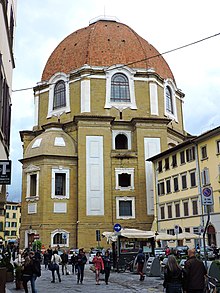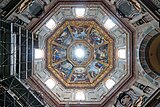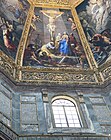| Cappella dei Principi | |
 Mausoleum Chapel of the Grand Dukes of Tuscany and their families Mausoleum Chapel of the Grand Dukes of Tuscany and their families | |
| Established | 1604 (1604) |
|---|---|
| Location | Piazza Madonna degli Aldobrandini, Florence, Italy |
| Coordinates | 43°46′30″N 11°15′11″E / 43.77500°N 11.25306°E / 43.77500; 11.25306 |
| Type | Art, Architecture |
| Visitors | 321,043 |
| Director | Monica Bietti |
Cappella dei Principi ("Chapel of the Princes" in English) is the mausoleum of the Grand Dukes of Tuscany and their families and is part of the museum complex of the Medici Chapels of Florence, adjacent to the Basilica di San Lorenzo.
History

The Chapel was based on the idea that the Grand Duke Cosimo II de' Medici wanted to create a monument for a family tomb. Work began on the tomb under Grand Duke Ferdinando I de' Medici who appointed architect and sculptor Matteo Nigetti in 1604, based on a design by Don Giovanni de' Medici, brother of the Grand Duke himself. Nigetti completed the mausoleum in 1640. He was assisted by architects Alessandro Pieroni and Don Giovanni de' Medici, Ferdinand's half-brother.
It has a large dome and marble interior. The octagonal room is 28 metres (92 ft) wide and is surmounted by the dome of San Lorenzo, which reaches a height of 59 metres (194 ft), the second most majestic in the city after Filippo Brunelleschi's dome.
During the first half of the eighteenth century, Italian noblewoman Anna Maria Luisa de' Medici, financed the construction of the large windows and cupola, and the internal decoration of the vault, which was executed by the painter Pietro Benvenuti between 1828 and 1837. The Chapel flooring of semiprecious stone inlay was only completed in 1962.
The octagonal room is almost entirely covered with stones and different-coloured marbles. The six porphyry sarcophagi of the Grand Dukes are contained in niches along the walls and complemented by bronze statues. The interior has rich inlays in commesso, also referred as Florentine mosaic, a method of piecing together semi-precious stones. The practice was started in 1588 by the famous artistic workshops, Opificio in Florence, using colored stones, mother of pearl, lapis lazuli, and coral to reproduce the coats of arms of the sixteen Tuscan cities loyal to the Medici family. The paintings in the dome are of the Creation, All, Dealth of Abel, Sacrifice of Noah, Nativity, Death and Resurrection, Last Judgment, are by Pietro Benvenuti.
The statues of the grand dukes for Ferdinand I and Cosimo II de' Medici were made by Pietro Tacca performed between 1626 and 1642. The other grand ducal tombs belong to Cosimo I (1519-1574), Francesco I (1541-1587), and Cosimo III (Succeeded Ferdinand II, 1643-1723). The Church of the Holy Sepulchre was to be located in the center of the atrium, although the various attempts to buy or steal it from Jerusalem failed.
The sarcophagus are actually empty and the real remains of the Grand Dukes and their family members (about fifty major and minor) up to Anna Maria Luisa de' Medici (last heir of the dynasty, 1667–1743), are kept in simple rooms created in the floor of the underlying crypt
From behind the altar there is access to a small room where other precious relics are displayed, some of which were donated to the city by Pope Leo X.
Early visits to the chapel
Dutch traveler Cornelis de Bruijn visited the chapel at December 12, 1674 AD. He writes, while describing his visit to Florence:
I also saw a very precious chapel that had been worked on for seventy-eight years, although it was far from being half-finished. This project was started by Ferdinand the First, Duke of Florence. In this chapel, there is a cushion that would have cost thirty thousand crowns, adorned with precious gemstones and decorated with the most beautiful stones obtainable. I was shown a marble stone on which five masters had worked for seven years before it could be used. The altar boasts five heavy pillars of cristal de montagne (rock crystal).
This description was later ascribed to be a referral to the Cappella dei Principi. If the statement regarding 78 years of work is true, it could indicate work on the chapel started as early as 1596, when Ferdinand was around 47 years of age. This would also indicate that the already mentioned architect Matteo Nigetti was appointed 8 years after the initial work had started.
Gallery
-
 Inlay of the coat of arms of Florence, from the chapel of the Princes
Inlay of the coat of arms of Florence, from the chapel of the Princes
-
 Chapel of the Princes Medici Chapels
Chapel of the Princes Medici Chapels
-
 Chapel of the Princes, early 17th century
Chapel of the Princes, early 17th century
-
 Dome of Capelle Medicee (The Chapel of the Princes)
Dome of Capelle Medicee (The Chapel of the Princes)
-
 Dome Painting at the Cappella dei Principi
Dome Painting at the Cappella dei Principi
-
 Statue and sarcophagus of Cosimo II de' Medici
Statue and sarcophagus of Cosimo II de' Medici
See also
References
- ^ "Medici Chapels and Church of San Lorenzo". The Museums of Florence. Florence, Italy. Retrieved 4 June 2023.
- ^ Baedeker, Karl (1899). Italy, Handbook for Travellers. K. Baedeker. p. 474. Retrieved 5 June 2023.
- ^ Grifi, Elvira (1899). Saunterings in Florence A New Artistic and Practical Hand-book for English and American Tourists. R. Bemporad & figlio. Retrieved 5 June 2023.
- Acton, Harold (1958). The Last Medici. Methuen. p. 310.
- "OPD Museum". Archived from the original on 2011-01-09. Retrieved 2022-06-05.
- Translated from old Dutch to modern English by ChatGPT, see original source in old Dutch
External links
- [REDACTED] Media related to Cappella dei Principi at Wikimedia Commons
| House of Medici | ||||||||||||||||||||
|---|---|---|---|---|---|---|---|---|---|---|---|---|---|---|---|---|---|---|---|---|
| People |
|  Festina Lente | ||||||||||||||||||
| Buildings |
| |||||||||||||||||||
| Patronage |
| |||||||||||||||||||
| Heraldry | ||||||||||||||||||||
| Institutions | ||||||||||||||||||||
| Art | ||||||||||||||||||||
| Related | ||||||||||||||||||||
